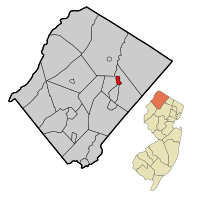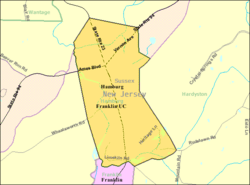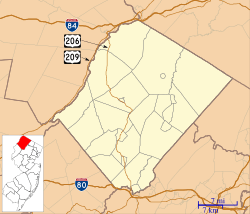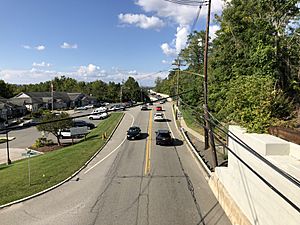Hamburg, New Jersey facts for kids
Quick facts for kids
Hamburg, New Jersey
|
|
|---|---|
|
Borough
|
|
| Borough of Hamburg | |

A church in Hamburg, New Jersey
|
|

Map of Hamburg in Sussex County. Inset: Location of Sussex County in New Jersey.
|
|

Census Bureau map of Hamburg, New Jersey.
|
|
| Country | |
| State | |
| County | |
| Incorporated | April 24, 1920 |
| Named for | Hamburg, Germany |
| Government | |
| • Type | Borough |
| • Body | Borough Council |
| Area | |
| • Total | 1.17 sq mi (3.03 km2) |
| • Land | 1.15 sq mi (2.96 km2) |
| • Water | 0.02 sq mi (0.06 km2) 2.05% |
| Area rank | 491st of 565 in state 22nd of 24 in county |
| Elevation | 538 ft (164 m) |
| Population | |
| • Total | 3,277 |
| • Estimate
(2019)
|
3,131 |
| • Rank | 441st of 566 in state 17th of 24 in county |
| • Density | 2,870.4/sq mi (1,108.3/km2) |
| • Density rank | 222nd of 566 in state 2nd of 24 in county |
| Time zone | UTC−05:00 (Eastern (EST)) |
| • Summer (DST) | UTC−04:00 (Eastern (EDT)) |
| ZIP Code |
07419
|
| Area code(s) | 973 |
| FIPS code | 3403729220 |
| GNIS feature ID | 885241 |
Hamburg is a borough in Sussex County, New Jersey, United States. As of the 2010 United States Census, the borough's population was 3,277, reflecting an increase of 172 (+5.5%) from the 3,105 counted in the 2000 Census, which had in turn increased by 539 (+21.0%) from the 2,566 counted in the 1990 Census.
In 1753, when Sussex County was formed, the area of present-day Hamburg was part of New Town; on February 25, 1762, it became part of the newly established Hardyston Township. On April 8, 1793, when Vernon Township was formed from Hardyston, Hamburg was included within the boundaries of Vernon. In 1852, the boundary line was changed so that Hamburg was again in Hardyston Township. Hamburg was incorporated as a borough on March 19, 1920, from portions of Hardyston Township, based on the results of a referendum held on April 24, 1920. The borough was named for Hamburg, Germany.
Contents
Geography
According to the United States Census Bureau, the borough had a total area of 1.165 square miles (3.016 km2), including 1.142 square miles (2.957 km2) of land and 0.023 square miles (0.059 km2) of water (1.96%).
Demographics
| Historical population | |||
|---|---|---|---|
| Census | Pop. | %± | |
| 1880 | 412 | — | |
| 1890 | 519 | 26.0% | |
| 1930 | 1,160 | — | |
| 1940 | 1,116 | −3.8% | |
| 1950 | 1,305 | 16.9% | |
| 1960 | 1,532 | 17.4% | |
| 1970 | 1,820 | 18.8% | |
| 1980 | 1,832 | 0.7% | |
| 1990 | 2,566 | 40.1% | |
| 2000 | 3,105 | 21.0% | |
| 2010 | 3,277 | 5.5% | |
| 2019 (est.) | 3,131 | −4.5% | |
| Population sources: 1880-1890 1930 1930-1990 2000 2010 |
|||
Census 2010
As of the census of 2010, there were 3,277 people, 1,364 households, and 884 families residing in the borough. The population density was 2,870.4 per square mile (1,108.3/km2). There were 1,476 housing units at an average density of 1,292.9 per square mile (499.2/km2)*. The racial makeup of the borough was 91.27% (2,991) White, 2.01% (66) Black or African American, 0.24% (8) Native American, 2.04% (67) Asian, 0.00% (0) Pacific Islander, 1.80% (59) from other races, and 2.62% (86) from two or more races. [[Hispanic (U.S. Census)|Hispanic or Latino of any race were 6.87% (225) of the population.
There were 1,364 households out of which 30.8% had children under the age of 18 living with them, 49.5% were married couples living together, 10.8% had a female householder with no husband present, and 35.2% were non-families. 29.4% of all households were made up of individuals, and 8.9% had someone living alone who was 65 years of age or older. The average household size was 2.40 and the average family size was 2.98.
In the borough, the population was spread out with 22.5% under the age of 18, 7.1% from 18 to 24, 30.2% from 25 to 44, 28.5% from 45 to 64, and 11.7% who were 65 years of age or older. The median age was 38.9 years. For every 100 females there were 94.3 males. For every 100 females ages 18 and old there were 88.4 males.
The Census Bureau's 2006-2010 American Community Survey showed that (in 2010 inflation-adjusted dollars) median household income was $64,016 (with a margin of error of +/- $6,681) and the median family income was $74,421 (+/- $13,156). Males had a median income of $66,083 (+/- $11,467) versus $40,735 (+/- $7,620) for females. The per capita income for the borough was $30,528 (+/- $3,671). About 7.0% of families and 7.8% of the population were below the poverty line, including 11.6% of those under age 18 and 12.8% of those age 65 or over.
Census 2000
As of the 2000 United States Census there were 3,105 people, 1,173 households, and 844 families residing in the borough. The population density was 2,686.6 people per square mile (1,033.5/km2). There were 1,233 housing units at an average density of 1,066.9 per square mile (410.4/km2). The racial makeup of the borough was 93.14% White, 0.74% African American, 0.29% Native American, 2.29% Asian, 1.67% from other races, and 1.87% from two or more races. Hispanic or Latino of any race were 4.22% of the population.
There were 1,173 households, out of which 37.3% had children under the age of 18 living with them, 57.7% were married couples living together, 10.5% had a female householder with no husband present, and 28.0% were non-families. 23.3% of all households were made up of individuals, and 6.0% had someone living alone who was 65 years of age or older. The average household size was 2.65 and the average family size was 3.14.
In the borough the population was spread out, with 26.8% under the age of 18, 7.1% from 18 to 24, 35.2% from 25 to 44, 22.8% from 45 to 64, and 8.1% who were 65 years of age or older. The median age was 35 years. For every 100 females, there were 92.1 males. For every 100 females age 18 and over, there were 90.9 males.
The median income for a household in the borough was $58,246, and the median income for a family was $64,773. Males had a median income of $45,729 versus $28,482 for females. The per capita income for the borough was $24,651. About 3.1% of families and 4.6% of the population were below the poverty line, including 5.9% of those under age 18 and 6.4% of those age 65 or over.
Transportation
Roads and highways
As of May 2010[update], the borough had a total of 11.04 miles (17.77 km) of roadways, of which 7.50 miles (12.07 km) were maintained by the municipality, 1.00 mile (1.61 km) by Sussex County and 2.54 miles (4.09 km) by the New Jersey Department of Transportation.
New Jersey Route 23 and New Jersey Route 94 intersect and pass through the borough.
Public transportation
Hamburg is served by the Sussex County Skylands Ride Service, which provides buses to Newton, Sparta, and Sussex.
Education
The Hamburg School District serves students in public school for kindergarten through eighth grade at Hamburg School. As of the 2018–19 school year, the district, comprised of one school, had an enrollment of 243 students and 29.3 classroom teachers (on an FTE basis), for a student–teacher ratio of 8.3:1.
Public school students in ninth through twelfth grades attend Wallkill Valley Regional High School together with students from Franklin Borough, Hardyston Township and Ogdensburg Borough. As of the 2018–19 school year, the high school had an enrollment of 604 students and 56.0 classroom teachers (on an FTE basis), for a student–teacher ratio of 10.8:1.
Notable people
People who were born in, residents of, or otherwise closely associated with Hamburg include:
- Joseph E. Edsall (1789–1865), represented New Jersey's 4th congressional district in the United States House of Representatives from 1845 to 1847, and the New Jersey's 3rd congressional district from 1847 to 1849.
- Daniel Haines (1801–1877), politician, jurist and lawyer who served as the 14th Governor of New Jersey.
- Robert Hamilton (1809–1878), represented New Jersey's 4th congressional district in the United States House of Representatives from 1873–1877.
- Heather Maloney (born 1985/86), singer-songwriter.
- Andrew J. Rogers (1828–1900), represented New Jersey's 4th congressional district in the United States House of Representatives from 1863–1867.
- Joseph Sharp (c. 1709–1776), iron manufacturer and industrialist who established an iron works that led to the area being known as Sharpsborough.
See also
 In Spanish: Hamburg (Nueva Jersey) para niños
In Spanish: Hamburg (Nueva Jersey) para niños





